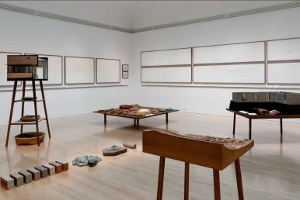
To look at most architecture today is to be left wanting. Normalized forms smooth over cultural differences, seemingly intent on vacating the practices of everyday life. Interiors, once hidden worlds supporting our particular needs, have suffered a similar fate. An unshakable feeling of emptiness, a deep void, is all that returns one’s gaze.
Rooms You May Have Missed reclaims the significance of inhabitation and is for that reason a collection of domestic spaces—entry porticos, kitchens, bedrooms, closets, dining rooms, courtyards, gardens, vestibules, living rooms, offices, dens and washrooms—as reinvented in the work of two very different architects: Umberto Riva in Milan and Bijoy Jain in Mumbai. Common to their practices is a genuine concern for the details that support living in and our common rituals of waking, bathing, eating, entertaining and sleeping.
Riva, who has operated for the past fifty years almost exclusively within his native city and country, dismantles the traditional organization of space as a sequence of individually defined rooms in order to achieve a fluid interior landscape. Jain, conscious of local customs and the ever-present Indian climate, shapes the volumes that characterize his work by considering their relationships with the courtyard, where inhabitants gather under open sky.
Whereas Riva works within the artisanal culture of craft production for which Italy was known in the 60s and 70s, Jain, who returned to India in the mid-90s having studied in the United States, has slowly absorbed the tacit knowledge of local materials and traditional construction methods left unclaimed by rampant industrialization. Riva is preoccupied with designing every detail of the spaces he creates, from lamps and doorknobs to pergolas and skylights, conferring dignity to even the poorest of materials. Jain surrounds himself with a wealth of resources both human and material, inserting his work into existing economies and systems of architectural production.
These “rooms,” located in Milan, Mumbai, Otranto or Ahmedabad and evoked in Riva and Jain’s installations at the CCA, are glimpses of thoughtful efforts to negotiate the intricacies of the everyday. Even if these interiors alone cannot redeem our private life, more an more in danger of disappearing, they offer holds on which to hang our most human practices, individual identities and desires.
 Rss feed
Rss feed Rss feed
Rss feed